Day 3 of a three day tour today, our last day. After two days down in the Brecks, we would spend the day up on the North Norfolk coast today, looking for some of our lingering winter visitors as well as one or two early spring arrivals. It was damp and drizzly for much of the day, but it didn’t stop us getting out and seeing lots of birds.
Our destination for the morning was Holkham. There were still quite a few Wigeon by Lady Anne’s Drive, but it looks like numbers are already starting to drop now as birds which have spent the winter here start heading back to Russia. The regular very pale Common Buzzard was perched on a bush out in the middle of the grazing marshes and six Marsh Harriers were hanging in the air over the reeds the other side.
We made our way straight through the pines and out onto the saltmarsh. A large flock of pipits circled over as we descended the boardwalk and we could hear both Meadow Pipits and Rock Pipits calling. Several of the Rock Pipits landed on the edge of the saltmarsh right by the path, where we could get a closer look at them. The Rock Pipits come here from Scandinavia for the winter. We could see some of them were moulting and getting slightly pink on the breast – they can begin to look increasingly like Water Pipits at this time of year, a pitfall for the unwary.

As we walked on further east, we scanned the saltmarsh for any movement. We were almost at the cordon before we found the Shorelarks, well hidden in the taller vegetation. At first we could only see one or two when they moved, but as we got closer we could see there were at least 5-6. As we stood and watched them, more and more appeared, so that by the end we had counted a minimum of 12, but it was still hard to know exactly how many were really there.
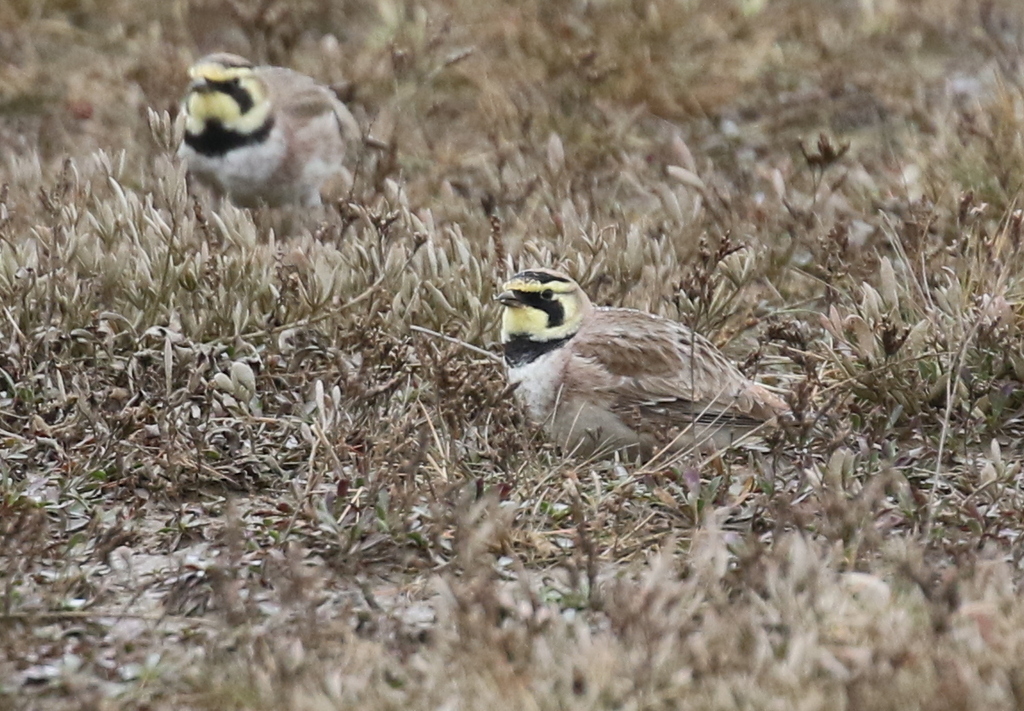
The Shorelarks are always one of the highlights of winter birding here on the coast, so we spent a bit of time watching them. They gradually worked their way closer to the path and we had a great look at them through the scope. Despite the grey weather, their yellow faces still really stood out when they lifted their heads. There were a few Linnets and Meadow Pipits feeding on the saltmarsh with them.
The latest forecast had been for it to be dry all morning, but at this point it started spitting with rain. It was only light, so we carried on out to the beach anyway. As we started scanning the sea, there didn’t look to be much out there today at first. There were a few Great Crested Grebes, and a lone female Common Scoter. Then one of group spotted diver quite close inshore – a Great Northern Diver. It was diving regularly and moving west steadily each time it resurfaced, but eventually we all got some good views of it between dives.
There were not many waders down on the beach today. Several Oystercatchers were standing along the shore, and two Sanderling were running in and out of the waves, at least until they were all flushed by someone walking a pack of dogs along the beach.
Making our way back to Lady Anne’s Drive, we decided to brave the drizzle and walked west along the path on the inland side of the pines. We hadn’t gone far before we heard a Chiffchaff calling in the trees. Along here, it is hard to tell whether this is a bird which has spent the winter here, or an early returning breeding bird. With the unseasonally warm weather at the end of February, Chiffchaffs have already returned very early in several places.
As we passed Salts Hole, we stopped for a quick look. A little group of Tufted Ducks was over on the edge of the reeds and one Little Grebe was still in the far corner. We could see a few geese out on the grazing meadows beyond and through the scope we could see there were several Pink-footed Geese with a pair of Greylags. Most of the Pink-footed Geese which spent the winter here have already left, on their way back north before they head back to Iceland for the breeding season, but a small number often linger here much later. There was a pair of Egyptian Geese out here too, and a Grey Heron.
A little further on, we stopped for another look out over the grazing marshes. We could see several Shelduck on the small pools out in the middle, and there were two drake Pintail in with them too, although for much of the time we could only see their elongated tail feathers sticking up as they upended. A Cetti’s Warbler sang from the reeds over in front of Washington Hide.
With the drizzle picking up a bit, we made our way quickly on to Joe Jordan Hide, to get out of the rain. It was quite busy in the hide (clearly lots of other people had the same idea to shelter in here!), but eventually we managed to sit down. A Great White Egret was feeding out on the grazing marshes off to the right of the hide.
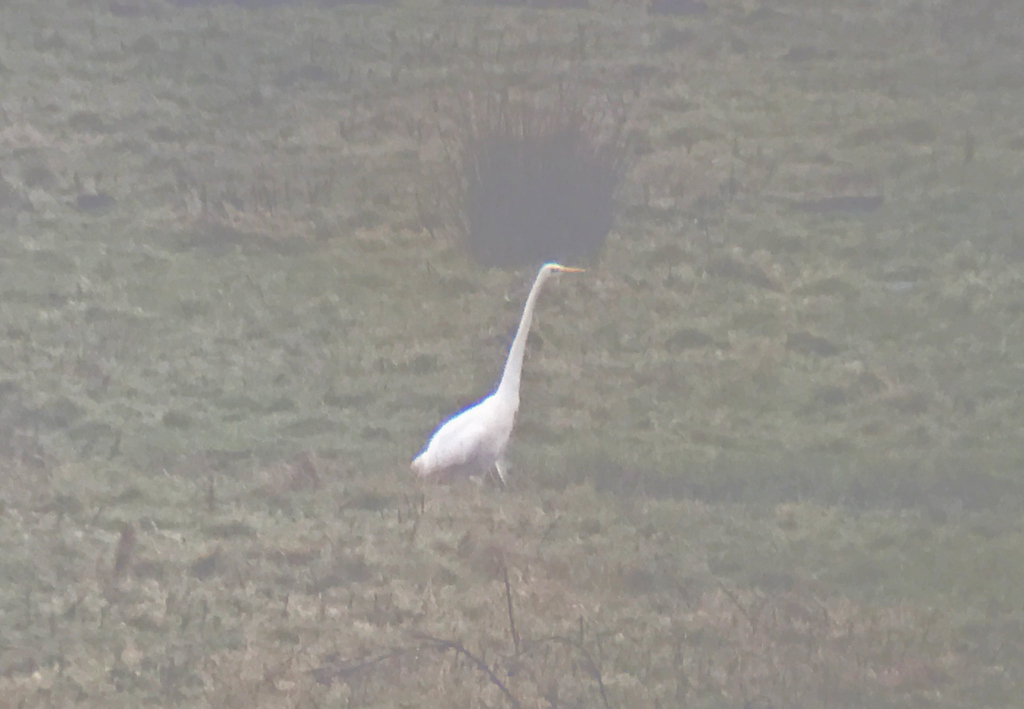
The first Spoonbills have already started to return to the breeding colony and we quickly located two out on the marshes, but they were way off in the distance and hard to see in the mist, heads down feeding in a ditch. Thankfully a bit later on one appeared much closer, and we had a better view of it in the scope. We could see its spoon-shaped bill when it lifted its head.
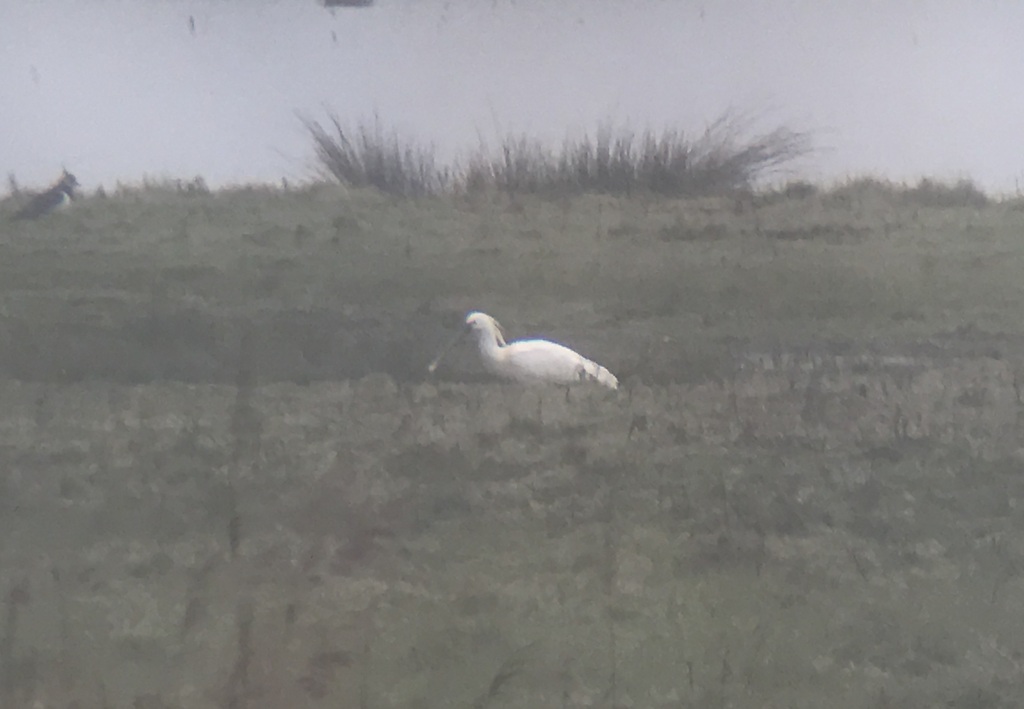
A Marsh Harrier was perched in a bush out along one of the ditch lines and there were lots of Cormorants in the trees behind the old fort. Down on the pools we could see four Avocets feeding in the shallows and several Shoveler and Teal scattered around.
The pines had been fairly quiet on the way out but as we started to walk back we came across a mixed flock of tits. We had passed some swarms of gnats gathered over the path in the damp conditions earlier and now we watched as a couple of Long-tailed Tits flew out from a large bush on the verge and hovered right out over the middle of the path, trying to catch some of the gnats. They hovered for second or two before flying back into the bush but then came out to try again. Really interesting to watch, and not behaviour you see often. A Goldcrest was flitting around in the bush too.
We stopped for lunch in The Lookout café, out of the rain. After lunch, as we made our way back to the van, we could see lots of gulls swarming over the grazing marsh, and landing down on the grass. We heard the distinctive call of a Mediterranean Gull and looking through the flock could see at least four in with the Black-headed Gulls.
Our next stop was at Holme. We were hoping to see some birds on the sea here so we walked straight out to the beach, where we were sheltered from the wind by the pines. There were lots of Red-breasted Mergansers on the water and scanning through we could see a dark duck in with them. It was a Velvet Scoter. You could just make out a pale spot on its cheek, but it was not until it flew round that you could see the diagnostic white in its wings. A small group of dark-winged Common Scoter flew past just afterwards.
Otherwise, the sea here was fairly quiet, with just a few Great Crested Grebes and a single Guillemot offshore. A couple of small groups of Brent Geese flew past and more unusually we picked up a flock of six Pink-footed Geese coming in off the sea. They should really be going the other way now!
Walking through the dunes to Gore Point, it was windier out of the lee of the Firs, although at least the rain had eased off now. The tide was coming in and there were a few waders roosting on the beach, at first several small groups of Oystercatchers. Further along, out on the point, we got the scopes on a flock of Bar-tailed Godwits. There were several smaller grey Knot in with them, as well as a couple of Grey Plover and a single Dunlin. A lone Turnstone was feeding on the shoreline a bit further along.
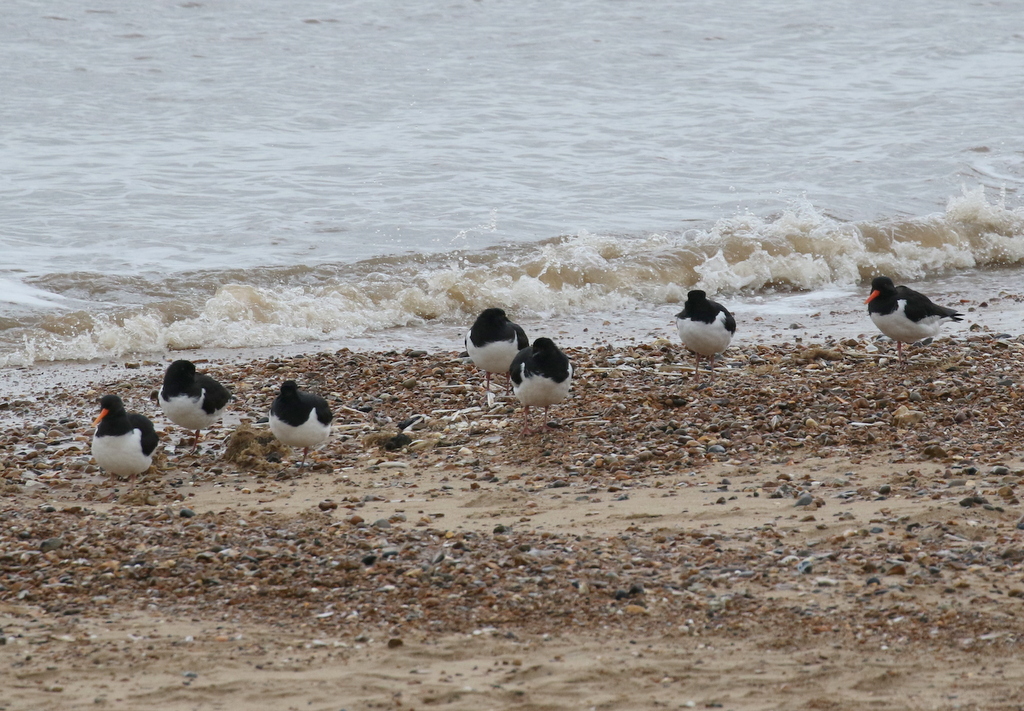
The sea was noticeably more choppy on the far side of the point. Scanning the sea from the shelter of the dunes, we could see a distant group of Eiders out on the water. A closer Red-throated Diver was diving constantly but a single Great Northern Diver was a long way out too. A Gannet and a Fulmar flew past.
We had wanted to see the Long-tailed Ducks off here, but they proved rather hard to find and harder still to see. We eventually found a few in with a larger group of Red-breasted Mergansers, but they were quite distant and diving constantly. Out in the choppier water, when they did surface they looked not unlike the froth on the wave crests and they kept disappearing into the troughs.
It was already getting late now, but we drove back along the coast to Titchwell to finish the day. We wanted to at least walk out to Parrinder Hide to get a proper look at the Mediterranean Gulls, but it took some time to find a Water Rail first. We eventually found one when it walked back into the bottom of the ditch from the vegetation in the bank beyond. We got a good look at it then, as it walked along through the water.

The rain may have eased but the wind had now picked up, and it was rather gusty this evening. The Marsh Harriers seemed to be enjoying it, with several up over the back of the reedbed as we walked out.
Three waders were on the pool out on Lavender Marsh. Two were the usual Common Redshanks, but as we glanced across the one asleep at the back looked rather pale. A quick look through the scope, confirmed it was slightly more silvery grey above, spotted with white, a touch lighter than the Common Redshank next to it. We could also just see tiny bit of pale supercilium, just visible where the bill was tucked into its back. It was a Spotted Redshank. They normally like to roost on the Tidal Pools, but it was perhaps a bit more sheltered on here this evening.

After we had all had a look at it through the scope, the Spotted Redshank woke up briefly and flashed its distinctive longer, needle-fine bill, just in case any of the group had any lingering doubts over its identity. A Grey Plover appeared from behind the vegetation at front.
The water level on the Freshmarsh is still fairly high – good for ducks, but not so good for waders. The Avocets which were on here were roosting on one of the only exposed small islands, by the corner of the path to Parrinder Hide.

As we headed straight down the path for the shelter of Parrinder Hide, we heard a Water Pipit call from the other side of the bank. When we got into the hide, we looked back along the edge of the water but there was no sign of it that way. A quick look out the other side of the hide and we found it feeding on the shore. We had a good look at it through the scope.
Having seen the closely related Rock Pipits this morning, it was interesting to contrast them with the Water Pipit this evening. The Water Pipit was noticeably whiter below, cleaner with more defined black streaks, with whiter wing bars and a whiter supercilium. It was also greyer above, not so oily olive-brown.
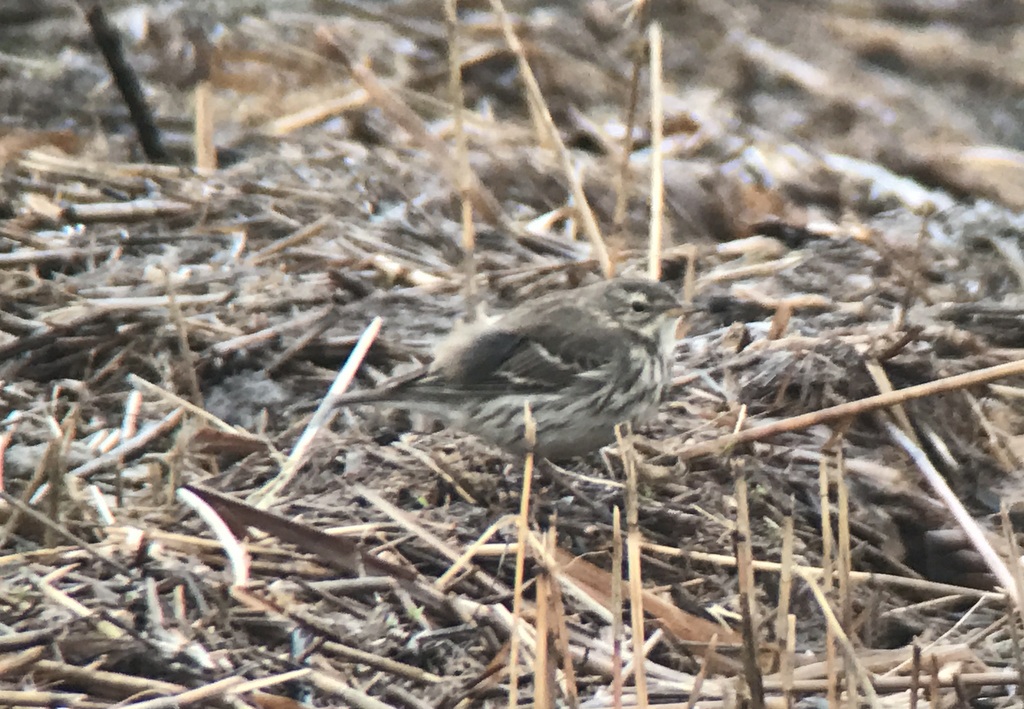
The fenced off Avocet Island was chock full of gulls (perhaps it should be renamed ‘Gull Island’!). We had come to see Mediterranean Gulls and there were lots here, in with Black-headed Gulls. Several appeared to be paired up already and were even still displaying. It was a good opportunity to compare the two species – the Mediterranean Gulls with a blacker, more extensive hood, heavier red bill and pure white wing tips.
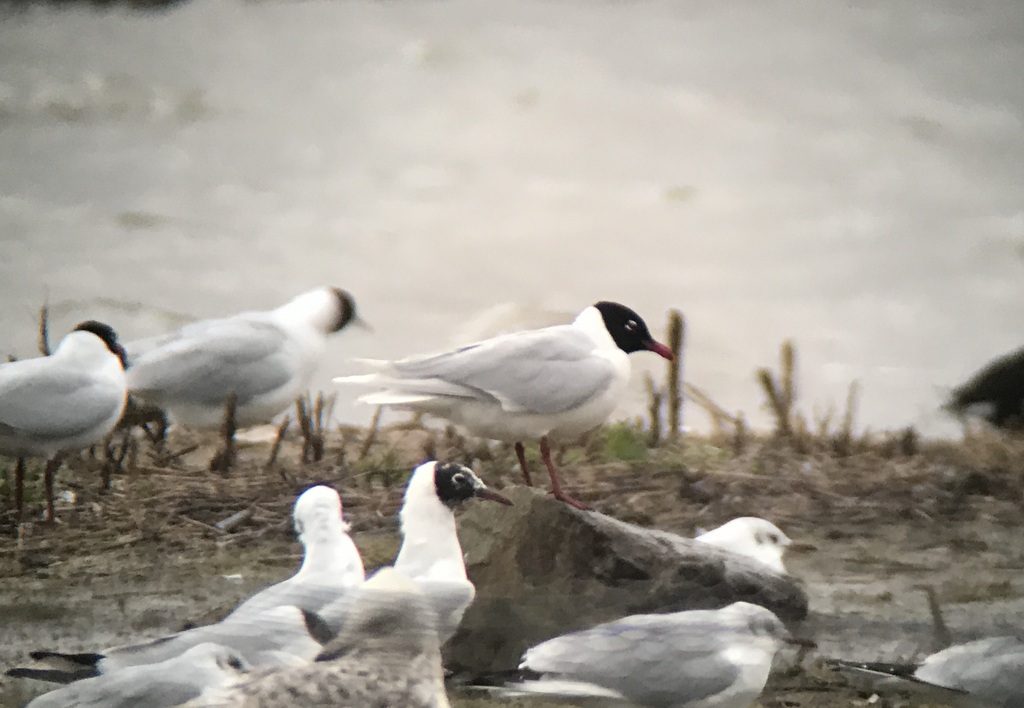
There were more gulls coming in to roost, bobbing around on the open water in the middle. As well as all the smaller gulls, we could see several Herring Gulls, Lesser Black-backed Gulls and a few Great Black-backed Gulls. We had a look at a few adults of each of the three species and talked about the main differences between them. (we decided to leave the more confusing immatures to a later lesson!).
The Marsh Harriers were gathering over the reedbed beyond to roost. More were flying in all the time – one came in over the Volunteer Marsh and straight over Avocet Island, sending all the gulls up into the air. The Marsh Harriers seemed to be playing in the wind this evening and we counted a minimum of twenty all in the air at the same time.
With all the excitement over the gulls, we had not noticed the time and it was already getting late. Unfortunately it was time to call it a day, and wrap up what had been three very successful day’s birding, despite the weather.
















